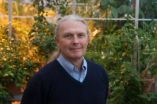(Press-News.org) Researchers at the University of Copenhagen have found that a protein, known for causing cancer cells to spread around the body, is also one of the molecules that trigger repair processes in the brain. These findings are the subject of a paper, published this week in Nature Communications. They point the way to new avenues of research into degenerative brain diseases like Alzheimer's.
How to repair brain injuries is a fundamental question facing brain researchers. Scientists have been familiar with the protein S100A4 for some time as a factor in metastasis, or how cancer spreads. However it's the first time the protein has been shown to play a role in brain protection and repair.
"This protein is not normally in the brain, only when there's trauma or degeneration. When we deleted the protein in mice we discovered that their brains were less protected and able to resist injury. We also discovered that S100A4 works by activating signalling pathways inside neurons," says Postdoc Oksana Dmytriyeva, who worked on the research in a team at the Protein Laboratory in the Department of Neuroscience and Pharmacology at the University of Copenhagen.
The villain turns out to be the hero
This research stands on the shoulders of many years of work on S100A4 in its deadlier role in cancer progression. The discovery represents a significant development for the new Neuro-Oncology Group that moved to the University of Copenhagen's Protein Laboratory Group from the Danish Cancer Society in October.
"We were surprised to find this protein in this role, as we thought it was purely a cancer protein. We are very excited about it and we're looking forward to continuing our research in a practical direction. We hope that the findings will eventually benefit people who need treatment for neurodegenerative disorders like Alzheimer's disease, although obviously we have a long way to go before we get to that point," says Oksana Dmytriyeva.
###
The scientific paper The metastasis-promoting S100A4 protein confers neuroprotection in brain injury can be found online in the journal Nature Communications.
Contact details
Professor Vladimir Berezin
Dept. of Neuroscience and Pharmacology
Telephone: +45 35 32 73 35 / +45 35 32 73 20
Mail: berezin@sund.ku.dk
Postdoctoral Researcher Oksana Dmytriyeva
Mail: mellis@sund.ku.dk
Communications Officer
Louise Graa Christensen
Faculty of Health and Medical Sciences
Mobile: +45 24 34 03 22
Mail: louise.christensen@sund.ku.dk END
Reconsidering cancer's bad guy
Researchers at the University of Copenhagen have found that a protein, known for causing cancer cells to spread around the body, is also one of the molecules that trigger repair processes in the brain
2012-11-16
ELSE PRESS RELEASES FROM THIS DATE:
Dartmouth research: The clocks are ticking and the climate is changing
2012-11-16
Dartmouth plant biologist C. Robertson (Rob) McClung is not your typical clock-watcher. His clocks are internal, biological, and operate in circadian rhythms—cycles based on a 24-hour period. Living organisms depend upon these clocks to keep pace with the Earth's daily rotation and the recurring changes it imposes on the environment. These clocks allow the plant or animal to anticipate the changes and adapt to them by modifying its biology, behavior, and biochemistry.
"If you know that the sun is going to go down, and if you are a photosynthetic plant, you have to readjust ...
Dartmouth research pursues problematic polymers
2012-11-16
"You look at the material world and see objects and how you can use them. I look at the material world and see a fascinating hidden life which is within our control, if we can only understand how it works," says Jane Lipson, the Albert W. Smith Professor of Chemistry at Dartmouth. Lipson looks at things from the point of view of both a chemist and a physicist. "What I do lies between the two sciences, and there is some engineering thrown in there, too," she says.
Lipson is a polymer chemist who, by definition, deals with long chain molecules composed of repeating structural ...
Are we closer to understanding the cause of deadly sepsis?
2012-11-16
New Rochelle, NY, November 13, 2012—Following an infection, dysregulation of the immune system can result in a systemic inflammatory response and an often fatal condition called severe sepsis or septic shock. Sepsis is not uncommon, yet its cause and underlying immune dysfunction remain poorly understood. Regulatory T cells (Tregs), a component of the immune system, now appear to have an important role in suppressing the immune response in advance of sepsis, and understanding this role may lead to new therapeutic strategies for improving patient outcomes, as described in ...
Gene distinguishes early birds from night owls and helps predict time of death
2012-11-16
BOSTON – Many of the body's processes follow a natural daily rhythm or so-called circadian clock. There are certain times of the day when a person is most alert, when blood pressure is highest, and when the heart is most efficient. Several rare gene mutations have been found that can adjust this clock in humans, responsible for entire families in which people wake up at 3 a.m. or 4 a.m. and cannot stay up much after 8 at night. Now new research has, for the first time, identified a common gene variant that affects virtually the entire population, and which is responsible ...
ORNL recipe for oxide interface perfection opens path to novel materials
2012-11-16
By tweaking the formula for growing oxide thin films, researchers at the Department of Energy's Oak Ridge National Laboratory achieved virtual perfection at the interface of two insulator materials.
This finding, published in the journal Advanced Materials, could have significant ramifications for creation of novel materials with applications in energy and information technologies, leading to more efficient solar cells, batteries, solid oxide fuel cells, faster transistors and more powerful capacitors.
The research team, led by ORNL's Ho Nyung Lee, demonstrated that ...
Teenagers urged to exercise to ward off bone disease
2012-11-16
An international team, including an expert from the University of Exeter, has found evidence that adolescents who spend long periods engaged in certain sedentary activities are more likely to have low bone mineral content in parts of the body where it can be an indicator of the risk of developing osteoporosis.
In the research, published by PubMed on November 15, the team found that studying put girls at particular risk, while for boys leisure internet use posed the greatest threat. Scientists found that participating in at least three hours of certain sports could significantly ...
How does groundwater pumping affect streamflow?
2012-11-16
Groundwater provides drinking water for millions of Americans and is the primary source of water to irrigate cropland in many of the nations most productive agricultural settings. Although the benefits of groundwater development are many, groundwater pumping can reduce the flow of water in connected streams and rivers—a process called streamflow depletion by wells. The USGS has released a new report that summarizes the body of knowledge on streamflow depletion, highlights common misconceptions, and presents new concepts to help water managers and others understand the effects ...
USDA funded research leads to key discoveries in the pig genome
2012-11-16
WASHINGTON, Nov. 15, 2012 – Research conducted and supported by the U.S. Department of Agriculture (USDA) has led to a new analysis of the pig genome, revealing new similarities between pigs and humans that could potentially advance biomedical research significantly. Additional findings from the study, reported today in the journal Nature, may also lead to better breeding strategies, improved pork production and improvements to human health. The research was conducted by a global team of scientists as part of the International Swine Genome Sequence Consortium (ISGSC).
"This ...
New research explores why we remember and why we forget
2012-11-16
Psychological scientists are exploring the mechanisms that underlie memory to understand why we remember certain things and why we forget others. Read about the latest research on memory published in the November 2012 issue of Psychological Science.
Retrieval-Induced Forgetting Predicts Failure to Recall Negative Autobiographical Memories
Failure to retrieve memories may not always be a bad thing - we might, for example, prefer to forget about certain instances of heartbreak or failure in favor of some of the more positive events from our lives. In this study, researchers ...
Fire the coach? Not so fast, says new study by University of Colorado, Loyola professors
2012-11-16
Fire the coach? Not so fast says a new study of elite college football teams.
Professors from the University of Colorado and Loyola University Chicago studied what happened to the records of college football teams that replaced a head coach for performance reasons in the Football Bowl Subdivision (formerly Division 1-A) between 1997 and 2010. Over this period, an average of 10 percent of FBS teams fired their coach each year because of the team's poor performance on the field.
The authors used statistical methods to compare groups of teams that were similar except for ...
LAST 30 PRESS RELEASES:
Sleeping in on weekends may help boost teens’ mental health
Study: Teens use cellphones for an hour a day at school
After more than two years of war, Palestinian children are hungry, denied education and “like the living dead”
The untold story of life with Prader-Willi syndrome - according to the siblings who live it
How the parasite that ‘gave up sex’ found more hosts – and why its victory won’t last
When is it time to jump? The boiling frog problem of AI use in physics education
Twitter data reveals partisan divide in understanding why pollen season's getting worse
AI is quick but risky for updating old software
Revolutionizing biosecurity: new multi-omics framework to transform invasive species management
From ancient herb to modern medicine: new review unveils the multi-targeted healing potential of Borago officinalis
Building a global scientific community: Biological Diversity Journal announces dual recruitment of Editorial Board and Youth Editorial Board members
Microbes that break down antibiotics help protect ecosystems under drug pollution
Smart biochar that remembers pollutants offers a new way to clean water and recycle biomass
Rice genes matter more than domestication in shaping plant microbiomes
Ticking time bomb: Some farmers report as many as 70 tick encounters over a 6-month period
Turning garden and crop waste into plastics
Scientists discover ‘platypus galaxies’ in the early universe
Seeing thyroid cancer in a new light: when AI meets label-free imaging in the operating room
Neutrophil-to-lymphocyte ratio may aid risk stratification in depressive disorder
2026 Seismological Society of America Annual Meeting
AI-powered ECG analysis offers promising path for early detection of chronic obstructive pulmonary disease, says Mount Sinai researchers
GIMM uncovers flaws in lab-grown heart cells and paves the way for improved treatments
Cracking the evolutionary code of sleep
Medications could help the aging brain cope with surgery, memory impairment
Back pain linked to worse sleep years later in men over 65, according to study
CDC urges ‘shared decision-making’ on some childhood vaccines; many unclear about what that means
New research finds that an ‘equal treatment’ approach to economic opportunity advertising can backfire
Researchers create shape-shifting, self-navigating microparticles
Science army mobilizes to map US soil microbiome
Researchers develop new tools to turn grain crops into biosensors
[Press-News.org] Reconsidering cancer's bad guyResearchers at the University of Copenhagen have found that a protein, known for causing cancer cells to spread around the body, is also one of the molecules that trigger repair processes in the brain


